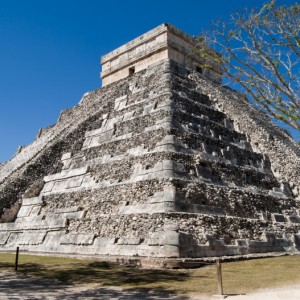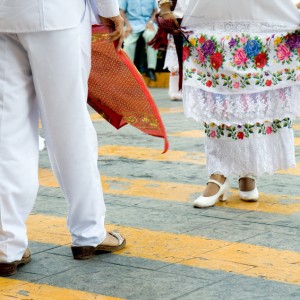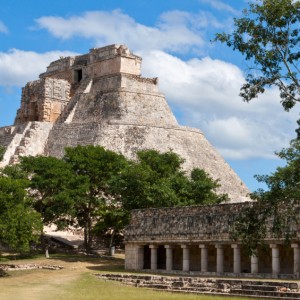
The Yucatan Peninsula certainly has spectacular beaches, however, many of our favourite aspects of this region of Mexico are found off the beach.
Chichen Itza. One of the most awe-inspiring, and most famous of the Mayan cities, Chichen Itza is a marvel of the ancient world, featuring extraordinary architecture in beautiful natural surroundings, and is a must-see for an unforgettable insight into this fascinating civilization.
Chichen Itza is dominated by Kukulkan’s Temple or El Castillo, the central pyramid that stands 90 feet high and is topped by a temple, and is a pilgrimage destination for thousands every Spring Equinox (March 21st), when the sun draws the shadow of a serpent down the pyramid’s steps.
Izamal. Yucatan’s first “Magical Town”, is located an hour east of Merida and known as the “town of three cultures”, due to the presence of Mayan, Colonial Spanish and contemporary architecture. Once a Mayan ceremonial center, the town is small and peaceful, easily explored on foot or by bicycle, with picturesque streets and pre-Hispanic structures alongside houses that date from Colonial times, many of which are painted yellow. The Kinich Kakmó pyramid downtown is the third tallest in Mesoamerica.
Mérida. The state capital, is an elegant city of Colonial-era houses. The Plaza Mayor, or main square, is a vibrant place of  rendezvous for the locals, especially in the early evening when the heat of the day has let up, and the ideal place to sit and drink a sorbet, a local specialty. The Cathedral of San Ildefonso, the oldest in Latin America, faces the square. Merida was very prosperous in the 18th and 19th centuries, and the wealth is tangible in the majestic mansions on Paseo de Montejo, and at the haciendas close to the city, many of which have been converted into beautiful boutique hotels. One of the newest attraction, Gran Museo del Mundo Maya has four permanent exhibition halls and a projection room focusing on Mayan culture, located beside the Siglo XXI Convention Center. The Bici-Ruta (Bicycle Route) is one of the biggest, and certainly the most active, weekly public events created with children and families in mind. This event is designed so that you can start on either end and move along according to whatever activity interests you the most. The listings that say “interactive activities” can be anything from a pickup soccer game to a cooking, art or music lesson. This is absolutely the best place for families with children on Sundays.
rendezvous for the locals, especially in the early evening when the heat of the day has let up, and the ideal place to sit and drink a sorbet, a local specialty. The Cathedral of San Ildefonso, the oldest in Latin America, faces the square. Merida was very prosperous in the 18th and 19th centuries, and the wealth is tangible in the majestic mansions on Paseo de Montejo, and at the haciendas close to the city, many of which have been converted into beautiful boutique hotels. One of the newest attraction, Gran Museo del Mundo Maya has four permanent exhibition halls and a projection room focusing on Mayan culture, located beside the Siglo XXI Convention Center. The Bici-Ruta (Bicycle Route) is one of the biggest, and certainly the most active, weekly public events created with children and families in mind. This event is designed so that you can start on either end and move along according to whatever activity interests you the most. The listings that say “interactive activities” can be anything from a pickup soccer game to a cooking, art or music lesson. This is absolutely the best place for families with children on Sundays.
Valladolid. Recently designated a “Magical Town” and founded by the Spaniards in 1543 as the regional capital, Valladolid boasts some remarkably beautiful buildings, such as the San Bernardino de Siena convent. Ideal for exploring on foot, the city has dozens of elegant streets, plazas and churches, as well as cafés and restaurants in which to savor delicious Yucatecan cuisine, which stands apart from that of the rest of Mexico.
Dzibichaltun. Located about 10 miles north of Merida, on the road to Progreso, is a Mayan city built around a cenote . The site’s highlight is the House of the Seven Dolls, named for seven effigies discovered there. Dawn on the Spring Equinox sends the sun shining directly through the building.
 Uxmal. South of Merida on highway 261, is another stunning and well preserved Mayan city, dominated by the Pyramid of the Magician, and which served as the epicenter of Mayan politics and culture at the time of the Spanish conquest. Uxmal is characterized by its highly decorative architecture and mosaics, such as those that spectacularly adorn the Governor’s Palace and the House of Turtles, and famous for its majestic light and sound show.
Uxmal. South of Merida on highway 261, is another stunning and well preserved Mayan city, dominated by the Pyramid of the Magician, and which served as the epicenter of Mayan politics and culture at the time of the Spanish conquest. Uxmal is characterized by its highly decorative architecture and mosaics, such as those that spectacularly adorn the Governor’s Palace and the House of Turtles, and famous for its majestic light and sound show.
Celestún. A beach town on the northwest of the peninsula, that still maintains the laid-back, fishing village ambiance. Take a boat from here to see the flamingos on the nearby lagoon, and the so-called petrified forest.
Ría Lagartos. A birdwatchers’ paradise, located on the northeastern edge of the peninsula, some 180 miles from Merida. The mangrove-lined estuary is home of the country’s largest flamingo population, as well as egrets and tiger herons, and crocodiles, which give the place its name.

